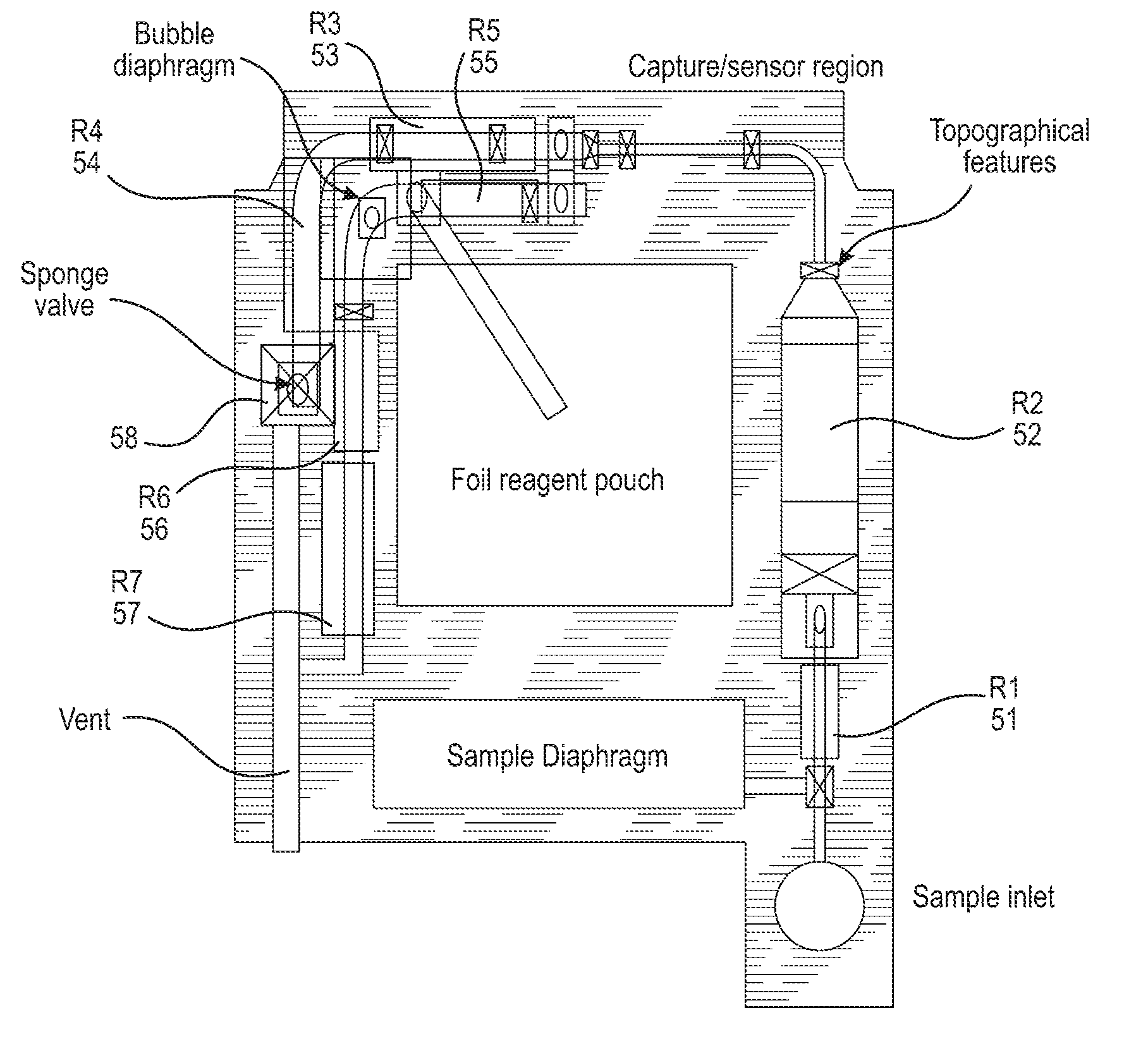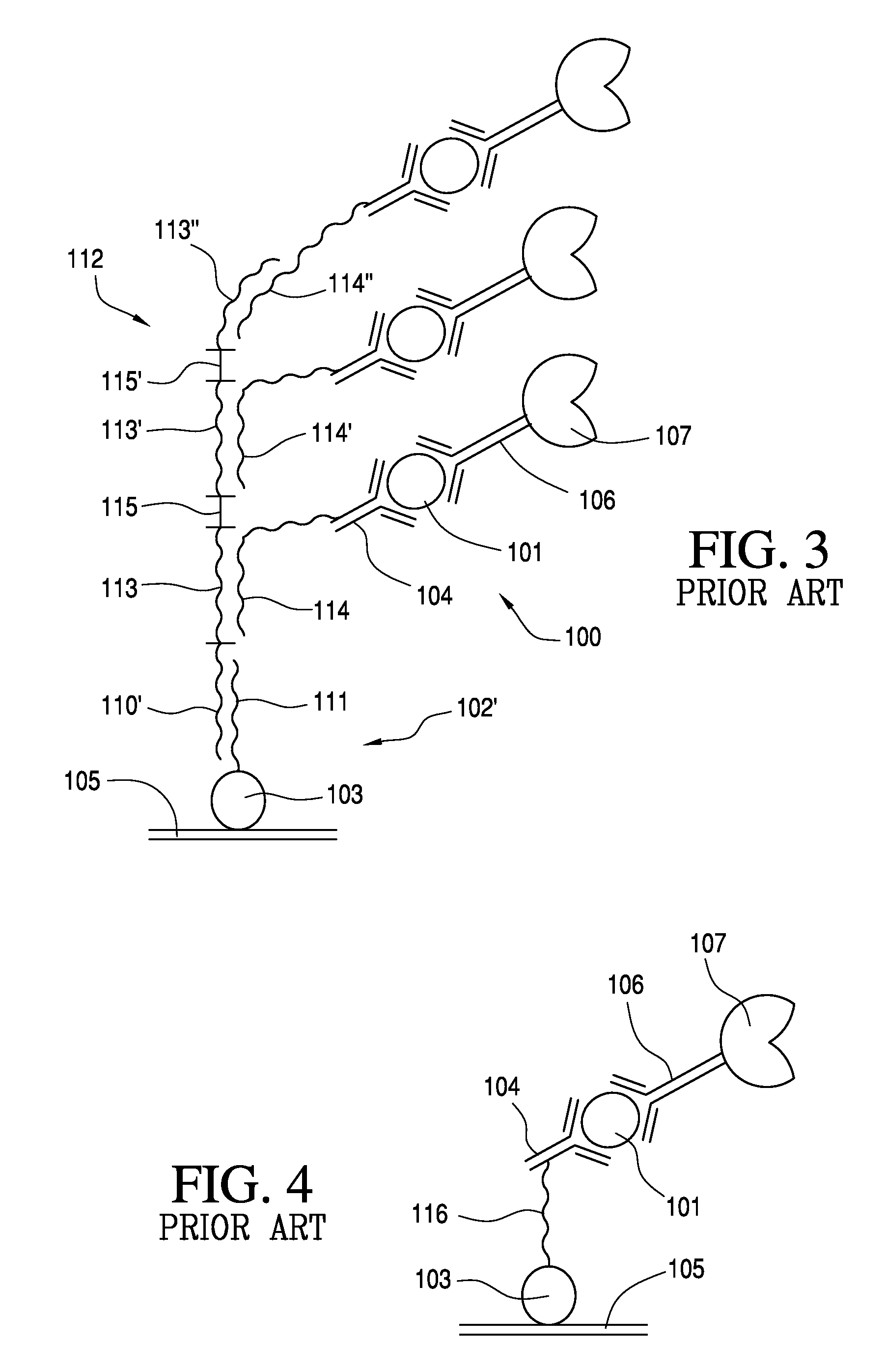Method and device for immunoassay using nucleotide conjugates
a nucleotide conjugate and immunoassay technology, applied in the field of immunoassay using nucleotide conjugates, can solve the problems of limiting the ability of current point-of-care immunoassay technology to reliably detect very low levels of target analytes, and reducing predictability and variable ratio
- Summary
- Abstract
- Description
- Claims
- Application Information
AI Technical Summary
Benefits of technology
Problems solved by technology
Method used
Image
Examples
example 1
[0138]The first example is an enzyme-linked immunoassay (ELISA) based on synthetic oligonucleotides to bridge a detection antibody and ALP enzyme as a conjugate for the analyte, as shown in FIG. 5.
[0139]This example demonstrates the basic concept of this system, wherein an ALP enzyme molecule uses a DNA scaffold to bind to a detection Ab or reduced F(ab) molecule, for use in an ELISA test. More complicated scaffolding molecules can be developed from this concept system.
[0140]The synthetic oligonucleotide sequences A and A′ are preferably those shown below.
A (DE)(SEQ ID NO: 1) 5′ amino C12-(T)20-TGATCGCTACGGTGGTATTGT-3′6-FAM where FAM is a fluorescent labelA′ (AP)(SEQ ID NO: 2)5′-thiol modifier C6 S-S-(T)20-ACAATACCACCGTAGCGATC*A-3′6FAMwhere FAM is a fluorescent label*denotes phosphorothioate linkage(T)20 denotes 20 ‘T’ residues
[0141]In order to demonstrate the entire system, the individual components were generated and tested for their functionality, as described below.
[0142]A set o...
example 2
[0176]A second example of the invention is an enzyme-linked immunoassay (ELISA) based on synthetic oligonucleotides to bridge the detection antibody and ALP enzyme as a polymeric conjugate for analyte as shown in FIG. 6. In this example, a signal conjugate is generated with a repeating complementary DNA sequence attached to the antibody which then hybridizes with multiple ALP-synthetic oligonucleotide conjugates that increase the possible signal generation at the capture site when analyte is present. The repeating complementary DNA sequence is generated by creating a circular piece of synthetic DNA, followed by the generation of complementary multimer DNA of this sequence using a 5′-thiol containing synthetic oligonucleotide as a primer sequence and using Phi29 DNA polymerase which is used in rolling circle amplification. The specific DNA sequence is then conjugated to an antibody molecule, followed by hybridization with ALP molecules conjugated with complementary synthetic oligonuc...
example 3
[0189]Another example of the invention is an enzyme-linked immunoassay (ELISA) based on synthetic oligonucleotides to bridge the detection antibody and ALP enzyme as a polymeric conjugate for analyte as shown in FIG. 6. In this example, a conjugate is generated with a repeating complementary DNA sequence attached to the antibody which then hybridizes with multiple ALP-synthetic oligonucleotide conjugates that increase the possible signal generation at the capture site when analyte is present. The repeating complementary DNA sequence is generated by cloning synthetic oligonucleotides into a phagemid, isolating single stranded DNA by techniques well known by those skilled in the art, followed by the generation of complementary multimer DNA of this sequence using a 5′-thiol containing synthetic oligonucleotide as a primer sequence and using T4 DNA polymerase (or any other DNA polymerase with a strand displacement capability). The specific DNA sequence is then conjugated to an antibody ...
PUM
| Property | Measurement | Unit |
|---|---|---|
| mol % | aaaaa | aaaaa |
| molar ratio | aaaaa | aaaaa |
| molar ratio | aaaaa | aaaaa |
Abstract
Description
Claims
Application Information
 Login to View More
Login to View More - R&D
- Intellectual Property
- Life Sciences
- Materials
- Tech Scout
- Unparalleled Data Quality
- Higher Quality Content
- 60% Fewer Hallucinations
Browse by: Latest US Patents, China's latest patents, Technical Efficacy Thesaurus, Application Domain, Technology Topic, Popular Technical Reports.
© 2025 PatSnap. All rights reserved.Legal|Privacy policy|Modern Slavery Act Transparency Statement|Sitemap|About US| Contact US: help@patsnap.com



